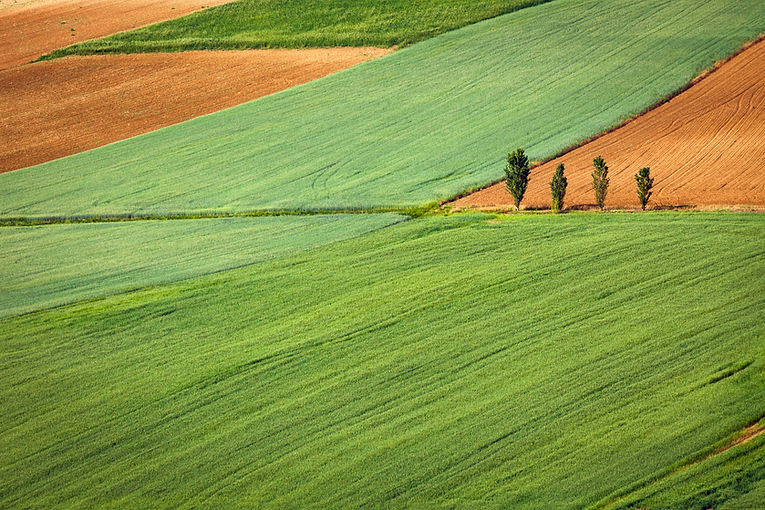What resolution imagery is best for monitoring tree crops?
- Adriaan van Niekerk

- Jan 13, 2019
- 4 min read
I am often asked about what resolution imagery is best for monitoring agricultural crops. This may seem like a simple question, but the answer is not simple at all. In this article I compare two types of satellite imagery, with very different characteristics, and demonstrate the advantages of each for managing tree crops.
Based on a previous post it should be clear that I am a big supporter of using freely available satellite imagery for monitoring crops. But the spatial resolution (the size of the pixels) of such imagery is sometimes a bit low for specific applications. For instance, the spatial resolution of freely available Sentinel-2 imagery is 10m, which means that each pixel covers an area of 10x10m. This is definitely high enough for most field crops (e.g. wheat and maize), but is it high enough for tree crops? Drones (unmanned aerial vehicles, UAVs) offer much higher spatial resolutions – typically 10cm or higher – while very high resolution (VHR) earth observation satellites offer imagery with resolutions of up to 30cm. The pixels of VHR imagery is thus much smaller than tree canopies, which is a major benefit for monitoring individual trees.
To demonstrate, Figure 1 compares a 50cm WorldView-2 (WV2) image (obtained from DigitalGlobe) to a 10m Sentinel-2 (S2) image captured on the same day. A 10m grid (white lines) is overlaid onto each of the maps to (more or less) represent the native resolution of the S2 image. Map 1 is a colour representation of the WV2 image (included for orientation), whereas a vegetation index was applied to the WV2 image to produce Map 2. Map 3 was created by resampling (enhancing) the native 10m resolution Sentinel-2 image to 3.3m.

When Map 3 is visually compared to Maps 1 and 2, it is quite noticeable that no trees or rows are visible in Map 3, while they are quite clear in Maps 1 and 2. A zone of poor growth (missing tees) is clearly visible in the centre of Maps 1 and 2 and one can also see that each 10x10m grid block covers several trees. But an area (zone) of relatively low growth vigour is also quite noticeable on Map 3 (the Sentinel-2 image). Nevertheless, the detail in Maps 1 and 2 are much more than in Map 3 which suggests that the Sentinel-2 image is less useful. But care should be taken when interpreting VHR imagery. The dark green and blue shades in Map 2 supposedly represent areas of very high growth vigour. But it is physically impossible for the growth vigour of the shadowed parts of a tree to be significantly higher than the parts that are fully illuminated. These lines of high vigour are thus caused by shadows and the bidirectional reflectance distribution function (BRDF), which I am not going to get into in this article (but is on my to-do list for a future article). Shadows is a major challenge when working with VHR imagery (in <10cm drone imagery it is even worse). Notice that the artefacts caused by shadows are not visible in Map 3, although shadows still influence the growth vigour values.
Figure 2 was generated using the same images as in Figure 1, but the maps were created at orchard-level (the location of the detailed area of Figure 1 is indicated by a red box). The higher detail of the WoldView-2 image (Map 1) is obvious even at orchard level, but the general patterns of growth vigour are highly comparable between the two images.

From these examples it would seem that VHR imagery is much more suitable for tree-level assessments. Even at orchard level (Figure 2) the fine detail provided by VHR imagery is very useful for identifying problematic areas within orchards. However, areas of low growth are also visible in the Sentinel-2 images, which shows that such imagery is suitable for managing zones within orchards.
When deciding on what imagery to acquire, one should keep in mind that VHR imagery comes at a cost. The question arises whether the acquisition of VHR imagery is cost-effective at short (e.g. weekly, monthly even quarterly) intervals. Many growers are unable to manage individual trees and rather manage zones within orchards. As demonstrated in this article, Sentinel-2 imagery is less noisy than VHR imagery and zones of poor growth are clearly visible on the maps generated from the Sentinel-2 imagery.
But the biggest advantage of Sentinel-2 imagery – apart from the fact that it is freely available that is – is its temporal resolution (interval at which an image is available of a particular area). The benefit of high image frequency is demonstrated in the animation below, which shows the variations in growth vigour of the orchards over a 10-month period. Some of the variations are due to farming practices (e.g. pruning), but others are due to stressed conditions. With such high frequency data one can identify zones that are consistently performing poorly, carry out very detailed change (phenology) analyses and even use the imagery in machine learning for predicting yields.
In conclusion, I believe that VHR imagery has a very important role to play in tree crop management. It is suitable for applications such as tree counting, pruning planning and for identifying tree-specific problems, which is not possible with lower (e.g. 10m) resolution imagery. Ideally, tree growers should acquire VHR imagery once a year (preferably during the growing season) to identify individual trees with significantly lower biomass compared to surrounding trees. But VHR imagery should be used correctly (i.e. radiometric errors and artefacts should be removed) and in combination with high temporal resolution imagery. This will enable informed decisions to be made at tree, management zone and orchard level.
This article was originally published on www.remotesensing.blog, which is devoted to articles about the use of remote sensing and other geospatial technologies for agricultural and related applications.
See related posts:













Comments